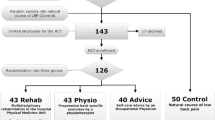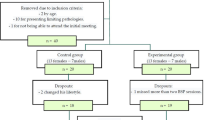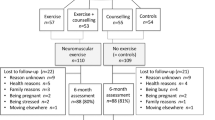Abstract
Background and objectives: In the last few years, several studies have focused on short-term treatment effects of exercise therapy. However, there is a lack of knowledge concerning the long-term treatment effects recorded after several years. Hence, this study was performed to investigate the short- and long-term effects of supervised physical training on functional ability, self-rated pain and disability in secondary prevention of low back pain. Methods: One hundred and eighty-three hospital employees with chronic low back pain were randomly assigned either to back school (comparison group), or three-months supervised physical training including a back school (exercise group). Various measurements of functional ability were performed and subjects completed questionnaires on self-rated pain, disability, and general well-being before treatment, immediately after intervention, and at six-months follow-up. At one-year and at ten-years follow-up participants evaluated treatment effectiveness. Results: Out of 183 employees, 148 completed the program. Participation at follow-ups ranged from 66 to 96%. Supervised physical training significantly improved muscular endurance and isokinetic strength during a six-months follow-up, and effectively decreased self-rated pain and disability during a one-year follow-up. At ten-years follow-up the subjects’ assessment of the effectiveness of treatment was significantly better in the exercise group. Conclusions: Supervised physical training effectively improved functional capacity and decreased LBP and disability up to one-year follow-up. The subjects’ positive evaluation of the treatment effect at ten-years follow-up suggests a long-term benefit of training.


Similar content being viewed by others
References
Antonovsky A (1987) Unraveling the mystery of health. How people manage stress and stay well. Jossey-Bass, San Francisco
Bendix AE, Bendix T, Ostenfeld S, Busch E, Andersen A (1995) Active treatment programs for patients with chronic low back pain: a prospective, randomized, observer-blinded study. Eur Spine J 4:148–152
Bendix AE, Bendix T, Heatrup C, Busch E (1998) A prospective, randomized 5-year follow-up study of functional restoration in chronic low back pain patients. Eur Spine J 7:111–119
Biering-Soerensen F (1984) Physical measurement as risk indicators for low-back trouble over a one-year period. Spine 9:106–119
Bigos S, Bowyer O, Braen G et al. (1995) Acute low back problems in adults. Clinical practice guideline No. 14. AHCPR Publication No. 95-0642. Public Health Service, Rockville
Capra P, Mayer T, Gatchel R (1985) Adding psychological scales to your back pain assessment. J Musculoskel Med 2:41–52
Cronbach LJ (1970) Essentials of psychological testing. Harper and Row, New York
Downie WW, Leatham PA, Rhind VM et al. (1978) Studies with pain rating scales. Ann Rheum Dis 37:378–381
DuPuy HJ, Ulin PR, Bullinger M et al. (1993) PGWB psychological general well-being index. In: Westhoff G (ed) Handbuch psychosozialer Messinstrumente. Hogrefe, Göttingen, pp 642–646
Frost H, Lamb SE, Klaber Moffett JA et al. (1998) A fitness programme for patients with chronic low back pain: 2-year follow-up of a randomised controlled trial. Pain 75:273–279
Glomsrod B, Lonn JH, Soukup MG et al. (2001) “Active back school”, prophylactic management for low back pain: three-year follow-up of a randomized, controlled trial. J Rehabil Med 33:26–30
Gunnari H, Evjenth O, Brady MM (1984) Sequence exercise. The sensible approach to all-round fitness. Dreyers, Oslo
Hansen, FR, Bendix T, Skov P et al. (1993) Intensive, dynamic back muscle exercises, conventional physiotherapy, or placebo-control treatment of low-back pain. A randomized, observer-blind trial. Spine 18:98–108
Hildebrandt J, Pfingsten M, Saur P et al. (1997) Prediction of success from a multidisciplinary treatment program for chronic low back pain. Spine 22:990–1001
Hodselmans AP, Jaegers SM, Goeken LN (2001) Short-term outcomes of a back school program for chronic low back pain. Arch Phys Med Rehabil 82:1099–1105
Holten O (1991) Medical exercise therapy—the basic principles. Fysioterapeuten 58:27–32
Isernhagen SJ (1991) Functional capacity evaluation and work hardening perspectives. In: Mayer TG, Mooney V, Gatchel RJ (eds) Contemporary conservative care for painful spinal disorders. Lea & Febiger, Philadelphia, pp 328–345
Kankaanpää M, Taimela S, Airaksinen O et al. (1999) The efficacy of active rehabilitation in chronic low back pain. Effect on pain intensity, self-experienced disability, and lumbar fatigability. Spine 24:1034–1042
Kannus P, Jozsa L, Renström P et al. (1992) The effects of training, immobilization, and remobilization on musculoskeletal tissue. Scand J Rehab Med 2:100–118
Keel PJ, Wittig R, Deutschmann R et al. (1998) Effectiveness of in-patient rehabilitation for sub-chronic and chronic low back pain by an integrative group treatment program (Swiss Multicentre Study). Scand J Rehab Med 30:211–219
Keeley J, Mayer TG, Cox R et al. (1986) Quantification of lumbar function. Part 5: reliability of range-of-motion measures in the sagittal plane and an in vivo torso rotation measurement technique. Spine 11:31–35
Kuorinka I, JonssonB, Kilbom A et al. (1987) Standardised nordic questionnaires for the analysis of musculoskeletal symptoms. Applied Ergonomics 18:233–237
Läubli T, Thomas C, Hinnen U et al. (1991) Erfassung muskuloskeletaler Beschwerden mittels Fragebogen. Sozial- und Präventivmedizin 36:25–33
Lonn JH, Glomsrod B, Soukup MG et al. (1999) Active back school: prophylactic management for low back pain. A randomized, controlled, 1-year follow-up study. Spine 24:865–871
Malmivaara A, Hakkinen U, Aro T et al. (1995) The treatment of acute low back pain–bed rest, exercises, or ordinary activity?. N Engl J Med 332:351–355
Manniche C (1996) Clinical benefit of intensive dynamic exercises for low back pain. Scand J Med Sci Sports 6:82–87
Mannion AF, Müntener M, Taimela S et al. (1999) A randomized clinical trial of three active therapies for chronic low back pain. Spine 24:2435–2448
Matheson LN (1993) Work hardening for patients with back pain. J Musculoskel Med 10:53–63
Mayer TG, Barnes D, Nichols G et al. (1988) Progressive isoinertial lifting evaluation I. A standardized protocol and normative database. Spine 13:993–997
Mayer TG, Gatchel RJ, Kishino H et al. (1985) Objective assessment of spine function following industrial injury. A prospective study with comparison group and one-year follow-up. Spine 10:482–493
Mayer TG, Gatchel RJ, Mayer H et al. (1987) A prospective two-year study of functional restoration in industrial low back injury. An objective assessment procedure. JMA 258:1763–1767
Mayer TG, Gatchel RJ (1988) Functional restoration for spinal disorders: the sports medicine approach. Lea & Felbiger, Philadelphia
Mayer, TG, Smith SS. Keeley J et al. (1985) Quantification of lumbar function. Part 2: Sagittal plane trunk strength in chronic low-back pain patients. Spine 10:765–772
Melzack R (1987) The short-form McGill Pain Questionnaire. Pain 30:191–197
Oliveri M, Kopp HG, Läubli T et al. (1996) Die Bedeutung von körperlicher Aktivität und physischer Leistungsfähigkeit für die Prävention und Behandlung chronischer Rückenbeschwerden. In: Keel P, Perini Ch, Schütz-Petitjean D (eds) Chronifizierung von Rückenschmerzen: Hintergründe, Auswege. Eular, Basel, pp 52–69
Pollock ML, Wilmore JH, Fox SM (1984) Exercise in health and disease. Evaluation and prescription for prevention and rehabilitation. Saunders, Philadelphia
Roland M, Morris R (1983) A study of the natural history of back pain. Part I. Development of a reliable and sensitive measure of disability in low back pain. Spine 8:141–144
van Tulder M, Malmivaara A, Esmail R et al. (2000) Exercise therapy for low back pain. A systematic review within the framework of the Cochrane collaboration back review group. Spine 25:2784–2796
Waddell G (1987) Clinical assessment of lumbar impairment. Clin Orthop 221:110–120
Waddell G (1987) A new clinical model for the treatment of low back pain. Spine 12:632–644
Acknowledgements
The authors acknowledge that the first part of the study (six-months follow-up period) was mainly developed and guided by M. Oliveri, and has been documented in a comprehensive report for the Swiss National Science Foundation and in an article for Eular [35]. The study was approved by the local Ethics Committee.
Author information
Authors and Affiliations
Corresponding author
Additional information
Supported in part by a grant of the Swiss National Science Foundation (Project NFP 26, No. 4026-27064) and by the BBW (Project “SOS-LBD”, No. 97.0046).
Rights and permissions
About this article
Cite this article
Maul, I., Läubli, T., Oliveri, M. et al. Long-term effects of supervised physical training in secondary prevention of low back pain. Eur Spine J 14, 599–611 (2005). https://doi.org/10.1007/s00586-004-0873-3
Received:
Revised:
Accepted:
Published:
Issue Date:
DOI: https://doi.org/10.1007/s00586-004-0873-3




